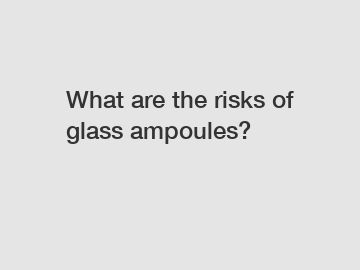What are the risks of glass ampoules?
Glass ampoules have long been a popular choice for storing and protecting various substances, from pharmaceuticals to essential oils. These small, sealed vials are designed to keep their contents safe and secure until they are ready for use. However, it is vital to be aware of the potential risks associated with glass ampoules to ensure their proper handling and prevent accidents or mishaps.
One of the primary concerns regarding glass ampoules is their fragility. Glass is inherently delicate and can easily shatter if not handled with care. A broken ampoule presents several risks, including the potential for cuts and injuries to those handling the ampoule, as well as the contamination or loss of the contents. Additionally, shattered glass can be difficult to clean up fully, creating potential hazards in the surrounding environment.
To mitigate the risks associated with fragility, it is crucial to follow proper handling procedures when working with glass ampoules. Always wear suitable protective gloves to minimize the risk of cuts or punctures. Carefully inspect each ampoule for any visible defects or damage before use, as even the tiniest crack can compromise its integrity. Using appropriate tools, such as ampoule breakers, during the opening process can also help reduce the likelihood of accidents.

Another risk associated with glass ampoules relates to their hermetic seal. While the airtight seal helps preserve the purity and efficacy of the contents, it also creates a potential problem if the ampoule is compromised. If air or contaminants are allowed to enter the ampoule, it can impact the stability and effectiveness of the stored substance. Therefore, it is essential to handle ampoules in a manner that prevents the seal from being damaged before use.
Proper storage is vital when it comes to maintaining the integrity of glass ampoules. Ideally, they should be stored in a cool, dark, and dry area away from direct sunlight or heat sources. Extreme temperature changes can cause the glass to expand or contract, potentially leading to breakage. Additionally, avoiding overcrowded storage spaces and ensuring ampoules are well-protected can help decrease the risk of accidental damage.
In the case of pharmaceuticals or chemicals, the risks associated with glass ampoules extend beyond physical hazards. Glass is generally inert and does not react with most substances. However, some pharmaceutical compounds or chemicals may interact with the glass material, leaching undesirable components or altering their properties over time. In such cases, it is advisable to consult with experts or manufacturers to ensure compatibility and assess potential risks.
The use of alternatives to glass ampoules, such as plastic or polymer-based vials, has gained popularity in recent years. These alternatives often offer improved durability, enhanced resistance to impact or breakage, and reduced risk of injury. However, they may not be suitable for all applications due to compatibility issues with certain substances or limitations in providing the same level of protection against light or gas permeability as glass ampoules.
In conclusion, while glass ampoules serve as useful containers for a wide range of substances, understanding and mitigating the associated risks is vital. The fragility of glass and the potential for injuries or contamination in the event of breakage require careful handling and disposal practices. Moreover, attention should be given to storage conditions and compatibility with the stored substance. By taking appropriate precautions and considering alternative options when necessary, the risks of glass ampoules can be minimized, ensuring their safe and effective use in various industries.
For more information, please visit pharmaceutical glass tube, Form C glass ampoule, borosilicate 5.0 glass tube.


